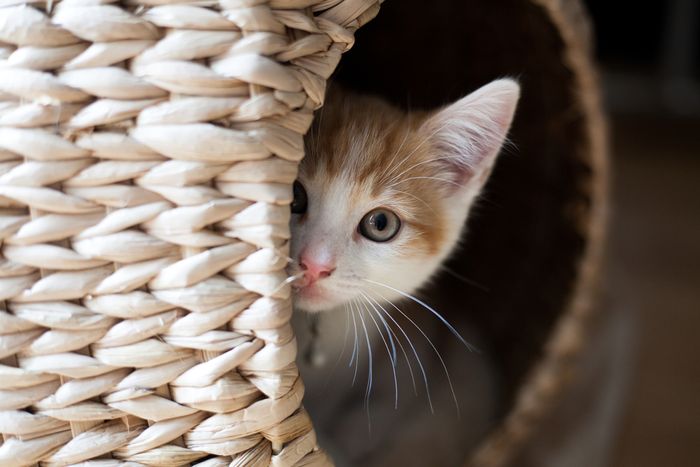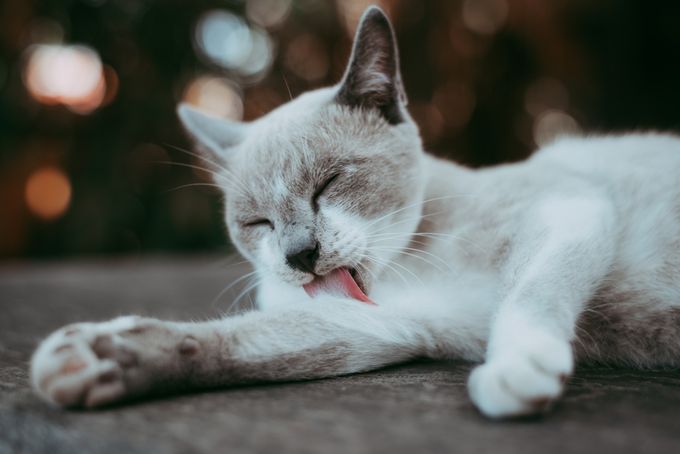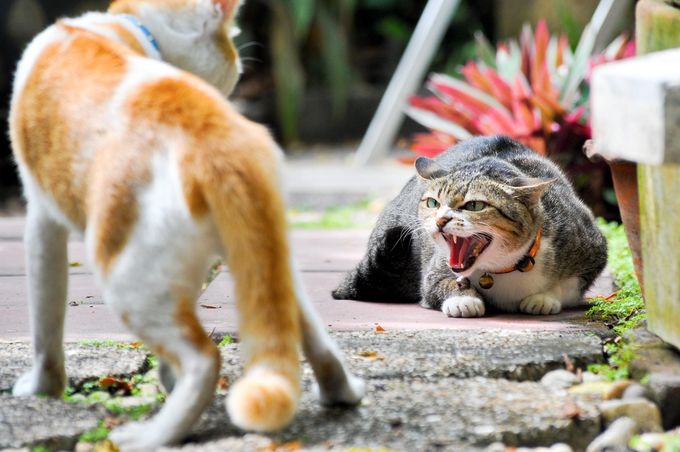7 Ways to Tell if Your Cat Is Stressed or Anxious
Updated August 14, 2023.

Our feline companions are complex creatures, with a natural predisposition to hide their discomfort and stress. These silent signals often go unnoticed by unsuspecting pet parents. Therefore, it's crucial to learn about the subtle changes in your cat's behavior that might indicate they're feeling anxious or stressed.
We'll delve into the intriguing world of feline behavior, learn how to recognize the symptoms of cat anxiety, and discuss effective strategies for looking after your furry friend.
We turned to Francesca Lees, a dedicated feline behaviorist, veterinary nurse and the founder of Wild Cats Feline Behaviour—a feline behaviour referral service for veterinary practices—to help us understand the behavioral nuances of stress and anxiety in cats.
1. Changes in Routine Activities
Cats are creatures of habit. They enjoy their routines and are particularly sensitive to even the smallest disruptions. If your cat suddenly retreats to isolated spots, avoids their favorite toys or napping spots, or shows changes in grooming or eating habits, it could be a sign of discomfort.
A lack of grooming can lead to matted fur, and a change in eating habits might manifest as refusal of dry food. These signs might hint at underlying health problems or indicate that your cat is feeling stressed. However, keep in mind that these behaviors might take a few weeks to surface, so it's important to observe patterns over time.
2. Signs of Separation Anxiety in Cats
While they’re known for their independence, cats also form strong bonds with their owners. Sociable breeds such as Siamese, Burmese, and Bengals are especially prone to experiencing separation anxiety.
If your feline friend begins to exhibit excessive meowing, pacing, inappropriate urination or scratching, or over-grooming when left alone, they could be expressing their distress at your absence.
"Some cats are very active at night and may wake their owners up by climbing all over them. This is especially true for cats that are very attached to their owners. Some people try to lock the cats out of the bedroom, but this can lead to problems like constant meowing at the door. Bengals are known for being able to jump at door handles and open doors, so even locked doors may not keep them out. They are very clever and can figure out how to open doors."
3. Scratching the Surface: Excessive Grooming or Scratching
Cats use grooming and scratching as ways to mark their territory and establish a sense of safety. However, when your cat begins to scratch or groom excessively, it could be a cry for help. This behavior is not just indicative of perceived territorial threats but can also be a sign of personal stress or certain medical conditions like orofacial pain syndrome.
More on the Orofacial Pain Syndrome
This condition affects the nerves in the mouth and tongue, causes significant pain, and can lead to excessive scratching of the face, mouth, and tongue. It’s more common in breeds like British Shorthairs.
» Learn more about why cats hide when they're sick
4. Panic Attacks and Acute Stress Response in Cats
In response to highly stressful events such as a vet visit, car ride, or an encounter with a hostile cat, cats may demonstrate an acute stress response.
Warning signs your cat is crying for help can include defecation, excessive drooling, vomiting, and open-mouth breathing, the latter being a particularly alarming indicator of severe stress.
5. The Solitary Retreat
Cats are known for their love of solitude, but a sudden change, such as retreating from their usual haunts or refusing to interact with others, should ring alarm bells. This act of self-isolation can be a red flag indicating stress or a medical issue. While it's essential not to panic, a vet visit is advised to rule out any health problems.
How to Get a Cat Out of Hiding
Coax a hiding cat with their favorite treats but allow them to emerge on their own terms.
One common cause of self-isolation is a physical confrontation with another cat which can happen if you have an unsecured cat flap or tend to leave the windows open.
If you do think another cat has been coming into your house and causing stress, consider installing a microchip cat flap to keep other cats out. You can also ensure that your doors and windows are locked when you're out to prevent other cats from entering. Other options include keeping your cat indoors or providing them with an outdoor enclosure to prevent them from coming into contact with other cats.
6. Aggressive Scratching or In-House Urination
A stressed cat might turn to unusual behaviors such as aggressive scratching or in-house urination as a way of expressing their discomfort. If your usually well-behaved feline friend starts damaging furniture or soiling outside the litter box, they may be communicating their emotional distress.
7. Visible Signs of Trauma
Traumatized cats often display visible physiological symptoms such as dilated pupils, flattened ears, bristled back hair, or a raised tail. Shock symptoms like pale gums or other mucus membranes suggest blood is being redirected to vital organs due to severe stress. These signs warrant immediate veterinary attention. It's important to remember that every cat reacts differently, and these signs can vary between individuals.
Can a Cat Die from Stress?
Traumatic experiences can be life-threatening, but not by itself. For example, minor injuries may seem insignificant, but they can result in severe physiological responses that need immediate veterinary intervention. Furthermore, persistent stress, while not directly lethal, can cause behavioral changes leading to harmful outcomes if left unmanaged.
How to Destress a Cat
Understanding your cat's stress signals is the first step to helping them.
Here are some practical tips:
- Ensure your cat has a safe space in your home where they can retreat if they're feeling overwhelmed.
- Spend quality time with your cat each day. Regular play and affection can greatly reduce their stress levels.
- Keep their environment consistent. Changes in their surroundings can lead to stress.
- If you need to introduce changes, do it gradually and make sure to offer positive reinforcement to help them adjust.
In order to ensure your cat feels safe and comfortable, you can use stress relievers like pheromone plugins, ensure regular playtime to cater to their hunting instincts, maintain frequent, low-intensity interactions, and schedule regular veterinary check-ups.
Always remember to approach your stressed cat with gentleness and patience. Additionally, supplements like L-tryptophan and soothing foods can aid in reducing stress levels in cats.
Does Catnip Help Cats With Stress?
Catnip can make cats excited and hyper, but it doesn't necessarily help them calm down.
Avoid Stressing Your Cat by Respecting Their Nature
It's easy to project our human emotions and perspectives onto our cats. After all, they're our beloved companions, and we share our lives with them. But cats are not small, furry humans; they're unique creatures with their own behavioral patterns, needs, and forms of communication. Understanding this difference and avoiding anthropomorphizing can significantly help reduce stress and anxiety in our feline friends.
- Respecting Their Unique Behavior: Cats are inherently solitary creatures and might prefer quiet spots and alone time, which shouldn't be misconstrued as them being aloof or unsociable. Forcing them into social situations or expecting constant interaction can be overwhelming and stressful for them.
- Adapting to Their Natural Rhythms: Cats are crepuscular, which means they're most active during dawn and dusk. Trying to adjust their schedules to fit ours can lead to discomfort and stress.
- Providing Separate Resources: In multi-cat households, we often expect our cats to share resources like humans do. But for cats, sharing food, water, and litter trays can lead to territorial disputes and stress. It's best to provide each cat their own resources in safe, private areas.
- Offering Choices: Cats value autonomy, and limiting their choices can lead to stress. Whether it's offering a variety of toys or providing multiple resting areas, giving your cats options can help them feel more secure and less stressed.
- Avoiding Unrealistic Expectations: We love our cats and often imagine them reciprocating our affections in human-like ways. However, cats show love and affection differently than we do, and expecting otherwise can lead to misunderstanding and unnecessary stress.
Addressing anthropomorphizing isn't about loving our cats less; it's about loving them more effectively by respecting their unique feline needs, instincts, and behaviors. In doing so, we create a harmonious environment that fosters their wellbeing and happiness.
» Is pet insurance worth getting for an indoor cat? Find out here
Becoming a Better Companion for Your Cat
The journey to understanding our feline friends requires patience, observation, and empathy. Recognizing their signs of stress or anxiety is not always straightforward. Not all cats will display all these signs, and some might even exhibit unique signs not listed. Every cat is an individual, and their responses to stress or anxiety can vary greatly.
In doing so, we become better companions, ensuring our beloved pets lead healthier, happier lives. Remember, when in doubt, it's always best to seek professional advice. Your cat might not thank you verbally, but their purrs and cuddles will tell you everything you need to know.


